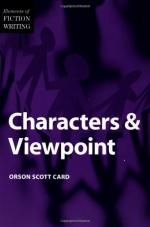
|
| Name: _________________________ | Period: ___________________ |
This test consists of 5 multiple choice questions, 5 short answer questions, and 10 short essay questions.
Multiple Choice Questions
1. How does Chapter 1 end?
(a) With the insignificance of a character's physical appearance.
(b) With the value of a character's previous experiences.
(c) With the insignificance of a character's previous experiences.
(d) With the value of a character's physical appearance.
2. What balance must be met when creating an endearing character?
(a) The balance between right and wrong.
(b) The balance between loss and hope.
(c) The balance between victimization and courage.
(d) The balance between a leader and a follower.
3. What can cause a reader to become more engaged with a character?
(a) Making what is happening to a character more important to only the minor characters.
(b) Making what is happening to a character more important to that character.
(c) Making what is happening to a character more important to all other characters.
(d) Making what is happening to a character more important to another character.
4. In Chapter 8, how does the author want the reader to be engaged with a character?
(a) Partially and gradually.
(b) Immediately, but partially.
(c) Fully and immediately.
(d) Fully, but gradually.
5. What can other characters provide for the main character?
(a) Conflict or assistance.
(b) Neither conflict nor assistance.
(c) Assistance, but never conflict.
(d) Conflict, but never assistance.
Short Answer Questions
1. What should the writer's own experiences have in order to be used as fictional inspiration?
2. How necessary is it for characters to be more than stereotypes in a narrative where an idea is the primary focus?
3. According to the quote that ends Chapter 3, where does the author believe a writer can find wonderful stories?
4. What kind of narrative should a storyteller use?
5. What is a writer's fundamental responsibility?
Short Essay Questions
1. In what way can the story itself provide a writer with additional characters?
2. How does a writer create a strong initial impression for a character?
3. What is a helpful tip about keeping track of character names that the author provides at the end of Chapter 4?
4. How well do readers want to know the fictional characters they are reading about, and what is the purpose of fiction in general?
5. As explained in the Introduction, on what are the author's suggestions based?
6. What are the two aspects of creative writing and what is the difference between them?
7. How does character factor into a narrative and why is it often a complex process?
8. What is the significance of a character's last name and why is that an important decision for a writer to make?
9. What is the contract that a writer makes with a reader, and when is it introduced?
10. What kind of act is writing and how does it compare to other mediums?
|
This section contains 983 words (approx. 4 pages at 300 words per page) |

|




